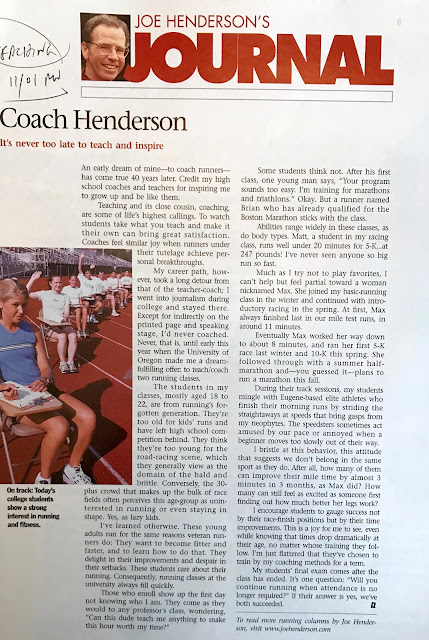(This is the 50th
anniversary of my first article in Runner’s World magazine.
All year I post excerpts from my book, This Runner’s World.)
November 2001
(retitled in the magazine). An early dream of mine took 40 years to come
true. My high school coaches guided me so well that I wanted to grow up and be
just like them.
Teaching the next generation, and if you’re lucky the one after
that, is one of the highest callings in life. Watching students take what you
teach and make it their own is one of life’s greatest joys. Coaching is simply
teaching by another name.
My career path took a detour into journalism during college. I
never coached – not in the formal, face-to-face sense, anyway, but only
indirectly and impersonally on the printed page and the speaking stage.
Never coached, that is, until this year when I received the offer
of a lifetime: to teach/coach running classes at the University of Oregon. I’ve
learned more from the students than I’ve taught them.
These students are from running’s forgotten age. They’re too old
for kids’ runs and have left high school competition behind, and they’re too
young for the fitness running and road racing that their age group generally
thinks of as old-people’s activities. Their parents and grandparents who run
view the young as uninterested in following their lead – lazy, even.
I’ve learned otherwise. Most of my students are traditional
college age, 18 to 22 or so. They run for the same reasons we elders did then.
They want to get fitter and faster, and to learn how to do that.
They delight in their improvement and despair of their setbacks.
These students care about their running, and more of them want to
run at the University of Oregon than the classes can accommodate. They don’t
care who their teacher is, at least not at the start.
They come the first day without knowing who I am. They come as
they would to any class, wondering, “Will he teach me anything to make this
hour worth my time?”
Some students think not. After one first-day talk a young man
said, “Your program sounds too easy for me. I’m training for marathons and
triathlons.”
Yet sticking with me was a runner named Brian who’d already
qualified for the Boston Marathon. Another, Liz, had run four years for the
local university team and now was its assistant coach.
Abilities range widely in these classes, as do body types. Matt, a
student in my racing class, ran well under 20 minutes for 5K... at 247 pounds.
I’ve never seen anyone so big run so fast.
I try not to play favorites based on ability. But I can’t help
feeling partial toward a woman who goes by the nickname of Max.
She joined the basic-running class in the winter and continued
with introductory racing in the spring. She never finished anywhere but the
back in our test runs.
Her first was an 11-minute mile, which she worked down into the
low eights. She ran her first 5K race last winter, then 10K in the spring and a
summer half-marathon, and she has a fall marathon in her sights.
During their track sessions, the students mingle with hotshot
young athletes who finish their morning runs by striding the straightaways at
speeds that brings gasps from the neophytes. The speedsters sometimes act
amused by our pace and sometimes act annoyed when a beginner moves out of their
way too slowly.
I’d rather work with a Max than the speedsters who think she
doesn’t belong on the same track (or even in the same sport) with them. How
many of them can improve their mile time by three seconds, let alone almost
three minutes, in three months? How many still feel as excited as someone first
finding out how much better her legs can work?
I encourage students to gauge success not by their speed or finish
position but by their improvement. Runners improve dramatically at college age,
by minutes at a time in distances as short as a mile or 5K.
This is a joy for me to see, even while knowing that their times
would drop no matter whose training they were doing. I’m flattered that they’ve
chose to try mine for a term.
My teachers/coaches were more successful than they ever knew. They
taught me what I needed to know to get along without them.
The final exam for each of my students comes after the class ends.
Its one question: “Will you continue running when attendance is no longer
required?” If the answer is yes, we’ve both succeeded.
2018 Update. My stay in
the UO P.E. department lasted 18 school years, ending only last spring. The satisfactions
continue as I still see many former students on race days, on the streets and
trails, and on social media.
[Many books of mine, old
and recent, are now available in two different formats: in print and as ebooks
from Amazon.com. The titles: Going Far, Home Runs, Joe’s Team, Learning to
Walk, Long Run Solution, Long Slow Distance, Next Steps, Pacesetters, Running
with Class, Run Right Now, Run Right Now Training Log, See How We Run, Starting
Lines, and This Runner’s World, plus Rich Englehart’s book about me, Slow Joe.]



